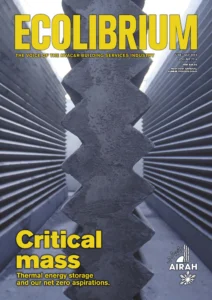Air of authority

With the release of a fast-tracked pathogen mitigation standard and updates to advice on building ventilation from the Center for Disease Control (CDC), the US seems to be taking the lead on indoor air quality. Ecolibrium asked three local experts for their views. Mark Vender reports.
In May 2023, the global HVAC&R community looked with interest towards the US, as ASHRAE released the first draft of Standard 241P – Control of Infectious Aerosols.
The standard provides minimum requirements for HVAC-related measures to reduce the risk of transmission of COVID-19, influenza, and other airborne viruses in homes, offices, schools, and hospitals during periods of high risk. This is important – the standard does not apply to normal operations, but when a building goes into Infection Risk Mitigation Mode (IRMM).
Another key feature of the standard is that it considers a combination of approaches to managing indoor air. It sets targets for equivalent outdoor air per person (EOAi) for different spaces, measured in litres per second per person (l/s/p). These rates can be achieved not only by the ventilation system bringing in more outdoor air, but also by reducing occupancy, or by using air cleaning devices – such as higher-grade filters.
It has been a remarkably fast turnaround for such a major piece of work, which began in December last year at the behest of the White House. And the timelines for finalising and publishing the standard are equally as ambitious. Comments closed at the end of May, with final approval expected this month (June) and publishing anticipated in July.
Given that this project has involved experts from around the world, and has been spurred by a clearly stated government goal of improving indoor air quality, Australia may well ask whether the work can help us make a much-needed leap forward – and whether our own government should be following the US example.
HVAC&R reached out to three Australian IAQ experts for their views on the standard and its implications for Australia.
Adapt 241P for local use
Melbourne-based Brad Prezant, Affil.AIRAH, is principal consultant at Prezant Environmental and a member of AIRAH’s IAQ Special Technical Group. He has a clearer view of Standard 241 than most, having worked as part of the project committee.
“Overall, the content is comprehensive and the speed at which it all came together is remarkable,” he says. “There were many people with significant expertise devoting many hours to the draft, and as a participant it was a unique exercise. The chairs and sub-group chairs took on an extraordinary task and completed it well.”
According to Prezant, the initial public comments on the draft have been “significant and copious” – which will be reflected in the final version. When it is published, Prezant says he would very much like to see Standards Australia review and adapt the ASHRAE standard for use in Australia.
“There is sufficient similarity in building HVAC system design and operation between the US and Australia that there would be considerable applicability in many of our most populated cities,” he says. “There may be adaptations that would be required in certain parts of Australia.”
As well as the ASHRAE standard, the US Center for Disease Control (CDC) has recently updated its advice on ventilation in buildings. Prezant notes that these recommendations are based on air changes per hour (ACH), while the approach in Standard 241P is to consider risk of infection and level that cross different space types with occupancies (assumed according to ASHRAE Standard 62.1) independent of ACH.
“The two approaches are different,” he says, “with advantages and disadvantages of each, and varying implications based on different space characterisations of volume and ACH. Note that ASHRAE 62.1 makes certain assumptions regarding occupancy and space volume, all of which influence risk of infection through their impact on ACH and ultimately concentration of ‘quanta’ – infected particulate – in the air in the far field. It is this metric that most impacts risk of infection, along with time of occupancy and activity rate, which define the dose of what is airborne.
“These complexities are still being worked out in the context of dovetailing with other recommendations, such as the CDC guidance on ACH.”
The recent US initiatives around ventilation suggest that the country is taking a more proactive approach to IAQ. But Prezant says there is some way to go.
“Generally, there has been more talk than action both here and in the US,” he says. “Whether this talk leads to meaningful change will depend on market forces and/or government mandates through the standards process and building codes.
“In the case of voluntary compliance programs that include indoor air quality criteria, such as NABERS, Green Star, and WELL, the market in Australia has created significant momentum and adoption, at least in office spaces among developers and owner-occupiers. So, market forces can be quite effective, and have been here in Australia.
“If we were to simultaneously develop more government-based mandatory standards for indoor air quality that include but extend beyond infection management to more general indoor air quality considerations, we would be taking these issues much more seriously, with actions that can really make a difference for health and productivity. Scientists have spoken out on the importance of these issues. It is up to the professional organisations and the politicians to sustain the momentum.”
“The content is comprehensive and the speed at which it all came together is remarkable”
A significant contribution
Dr Claire Bird, Affil.AIRAH, is secretary of the international Integrated Biosciences and Built Environment Consortium (IBEC). Bird is also co-chair of the AIRAH IAQ STG and from this position has coordinated STG members’ varied responses to the draft standard.
She notes that the draft standard primarily focuses on tackling the long-range transmission of infectious aerosols rather than between people at close quarters. The draft standard outlines the minimum requirements for buildings to adopt when they enter infection risk mitigation mode (IRMM).
“In simpler terms, this mode aims to minimise the risk of infection when it is at its highest,” says Dr Bird. “The current document concentrates on establishing thresholds for equivalent outdoor air exchange rates. These thresholds are based on the combined impact of ventilation, filtration, and air cleaning, whenever necessary, to achieve the desired values during periods of high risk of transmissible airborne disease.
“Additionally, the standard provides recommendations for minimum HVAC maintenance tasks and their frequency. It also offers guidance for reducing infection risk in residential and healthcare settings. Therefore, I can confidently say that the standard will make a significant contribution to the Australian market. However, as is customary, we will need to convert formulas and thresholds from imperial/US to metric units of measurement.”
Dr Bird highlights that the standard also delves into the realm of reducing infection transmission risk. It does this by optimising room air distribution, evaluating the effectiveness and safety of filters and air cleaners (with regard to unintended emissions), and emphasising the importance of commissioning.
“A crucial aspect of the overall document is the development and implementation of a Building Readiness Plan, which plays a pivotal role in preparedness,” she says.
“It is important to note that the document primarily focuses on building and supplemental controls, and does not delve into determining human factors. For instance, it establishes a maximum permitted density of people in each occupied building zone during IRMM (Infection Risk Mitigation Mode) periods, but it does not prescribe how that limit should be derived. Furthermore, the standard does not provide health-based or public health criteria that would trigger a transition from normal mode to IRMM.”
Dr Bird says that at first glance, there seems to be less emphasis on preventive measures aimed at improving general air quality and reducing lower levels of infection spread.
“However, it is worth mentioning that the testing components of the standard are applicable to filters and technologies deployed for day-to-day enhancements in air quality,” she says.
In comparison, Dr Bird says the efforts to improve indoor air quality in Australia have been slower, potentially influenced by the rapid uptake of vaccinations in the country.
“Nevertheless, groups of dedicated scientists, such as those associated with IBEC globally and the scientists involved with OzSage in Australia, have consistently emphasised the significance of airborne transmission as the primary route of infection for respiratory diseases, right from the early stages of the COVID-19 pandemic.
“Although initiated in response to the evident airborne spread of COVID-19, we continue to encounter challenges regarding the transmission of airborne pathogens. The rise in cases of respiratory syncytial virus (RSV), influenza, and infectious Group A Streptococcal disease (including childhood pneumonia) leading to hospitalisations and severe illness underscores the importance of implementing measures to mitigate pathogen transmission. Furthermore, the persistent growth in the number of patients experiencing long-COVID complicates the assessment of when we can safely transition from an infection risk mitigation mode. It is clear that we are still in a phase where pathogen transmission mitigation remains crucial.”
“In simpler terms, this mode aims to minimise the risk of infection when it is at its highest”
Reason to be optimistic
Dr Jason Monty is a Professor of Fluid Mechanics and head of the Department of Mechanical Engineering at the University of Melbourne. He says parts of the ASHRAE standard could definitely be adapted for Australia, and highlights the table listing minimum equivalent outdoor air per person for infection control.
“The airflow rates in this document are very, very high,” he says. “In some cases, recommended airflow rates per person are as high as 90L/s/person, which is six times higher than even the WHO recommendation for ventilation.
“Of course, this is only for pandemic preparedness, not for regular ventilation settings. This has particular importance for hospitals. Future design guidelines and construction codes for hospitals, aged-care and other sensitive settings should take note of this new standard.”
Dr Monty points out that the standard provides a comprehensive set of guidelines and methods to calculate equivalent outdoor air (EOA) within a space.
“Importantly, this is not only ‘outdoor’ or ‘fresh’ air, but rather the combination of outdoor and fresh air with ‘cleaned’ air,” he says. “The cleaned air may come via portable HEPA filters or UVGI.
“It is excellent that ASHRAE are taking this comprehensive view, which gives facilities managers, building engineers, designers and tenants the opportunity to design for safe air via combined methods for delivering ‘clean’ air. Previously these have been separated, and one is left to consider either HVAC upgrades/changes or alternative air-cleaning methods.
“Now both can be considered together – or one could design for ‘pandemic mode’, where HVAC does regular time work and during an infectious disease outbreak, extra cleaning technologies could be brought online according to this standard.”
The US leadership on IAQ reflects how quickly the issue was prioritised by government, says Dr Monty.
“Some ministers in the (Australian) federal government invited the majority of clean air experts in Australia to the Clean Air Forum in Canberra on March 25, 2023,” he says. “Joe Biden’s administration hosted their Clean Air Summit in June 2022. Optimistically, we are one year behind the USA on this issue!
“Lidia Morawska is leading Australian scientists and industry, together with prominent people such as Bronwyn King and Guy Marks, to lobby government further. Any efforts from members of industry bodies to lobby government to follow the USA path would be most welcome.
“There is reason to be optimistic that Australia will take indoor air quality more seriously in the short term. New standards in other countries, such as these ASHRAE standards, will only help us in our campaign, since Australia often adopts such standards and is likely to respond with our own changes to codes, standards and guidelines as a result.”
Brad Prezant, Affil.AIRAH and Dr Claire Bird, Affil.AIRAH will both be speaking at AIRAH’s IAQ Conference on July 17–18 in Brisbane.
For more information and to register, go to airah.org.au/iaq

This article appears in Ecolibrium’s June-July 2023 edition
View the archive of previous editions
Latest edition
See everything from the latest edition of Ecolibrium, AIRAH’s official journal.





